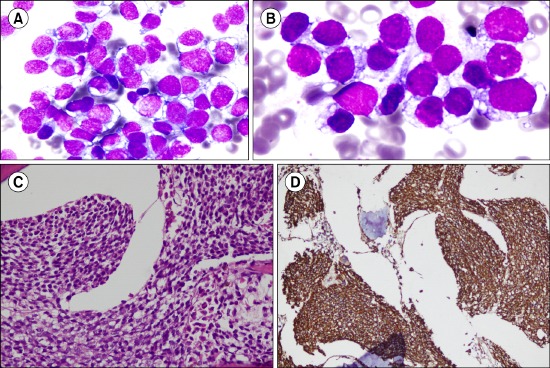
A 34-year-old man presented with dyspnea, cough, and vertigo for 3 months, and persistent backache for 9 months. He was febrile and pale with no organomegaly. Blood examination revealed hemoglobin, 8.7 g/dL; white blood cell count, 11.3×109/L; and platelet count, 430×109/L. Blood film revealed hypochromic, microcytic red cells with few myelocytes. Serum creatinine and liver enzyme levels were normal. Computed tomography revealed mediastinal and hilar lymphadenopathy with multiple lung, liver, and bone nodules. Skeletal scintigraphy showed generalized bony involvement. Pelvic magnetic resonance imaging revealed abnormal soft tissue masses within the epidural spaces of the L4-S1 vertebra; mediastinal lymph node biopsy was consistent with Ewing sarcoma. Staging bone marrow examination revealed large, non-hematopoietic, neoplastic cells with hyperchromatic nuclei and abundant pale blue cytoplasm with coalescing vacuoles (A, B; Leishman staining; ×1,000). Bone trephine showed mononuclear cell sheets (C; hematoxylin and eosin; ×400) strongly expressing CD99 (D; Paraffin-embedded tissue; ×200). The patient died of extensive tumor burden during palliative treatment.
Ewing sarcoma is the second most common pediatric tumor. It is rare in adults but should be considered among differential diagnoses. It can occur in bones and extraosseous sites. The incidence of bone marrow involvement in Ewing sarcoma is 52%.




 PDF
PDF ePub
ePub Citation
Citation Print
Print


 XML Download
XML Download